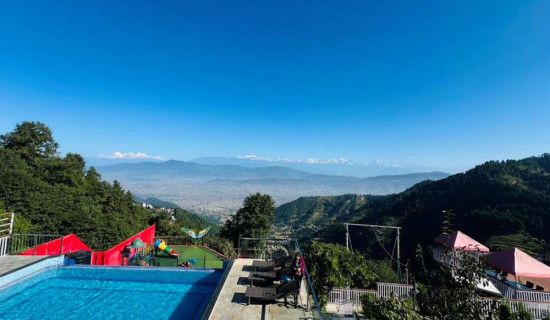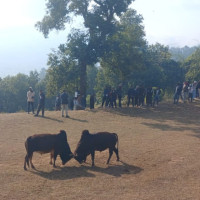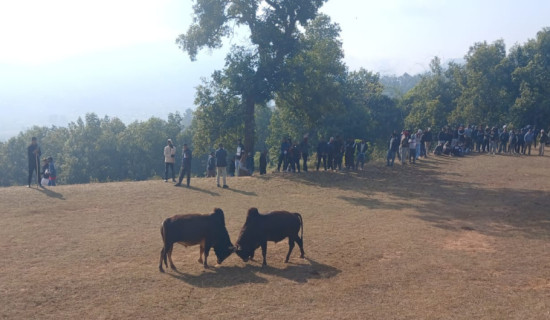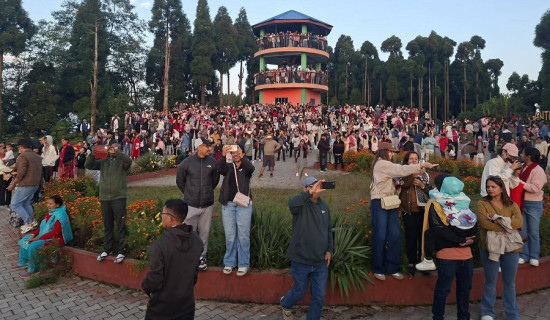- Thursday, 1 January 2026
Nepal's second largest Sal tree identified in Dhanuadham forest
By Vijay Kumar Sah,Dalkebar, July 9: Nepal’s second largest and historic Sal (Shorea robusta) tree has been identified inside the protected forest area of Dhanushadham in Dhanusha district.
According to the forest officials, this tree is around 200 years old and has a girth of 15 feet. It has been named the ‘Dhanusha Sal’.
According to Binod Singh, Chief of the Division Forest Office, Dhanusha, the largest Sal tree in Nepal is currently the ‘Bhima Sal’ located in Bhimanagar, Bara, with a girth of 18 feet and an estimated age of around 250 years. The second largest and oldest Sal tree has now been found in Dhanushadham.
It is believed that this may be the only place in Nepal where so many ancient trees are found together.
On Friday, Chief Minister of Madhes Province, Satish Kumar Singh, officially named the tree ‘Dhanusha Sal’. On the occasion, he shared his view that the Dhanushadham forest area, which is historically, religiously and biologically important, could be developed as an open-air museum.
He said, “This forest, filled with century-old trees, is a combination of biodiversity, cultural importance and tourism potential.”
The Chief Minister also shared that the provincial government has already allocated the required budget to build a zoo within the protected forest area. Emphasising that sustainable conservation is not possible without local participation, he said the area should be developed as a centre for ‘green heritage and green tourism’.
Shankar Narayan Jha, a forest officer at the Dhanushadham Sub-Division Forest Office, shared that the protected forest area currently has 8,687 trees of various species, out of which more than 200 are century-old Sal trees.
He said, “This is probably the only forest area in the country where so many ancient trees are found in one place.” Devnarayan Mandal, Chairperson of the Mithila Wildlife Trust, said that the Dhanushadham forest is not just home to ancient trees, but also serves as a living museum of biodiversity. He added, “This area has more than 286 species of birds, including endangered species like the Spotted Eagle and Hornbill.”
According to him, the forest is also home to dozens of mammals such as King Cobras, wild boars, deer and rabbits. He also mentioned that the forest contains more than 270 types of herbs and medicinal plants, making it a potential hub for research in Ayurveda, biology, and botany. The protected forest area of Dhanushadham currently spreads over 360 hectares. Environmental activist and forest officer Suresh Sharma said that the area is a unique combination of biological, cultural and educational heritage.
He explained, “These Sal trees have silently witnessed countless seasons over the years. They are a priceless gift for future generations. Protecting such a natural museum is everyone's responsibility.”
He added that the area, known for its religious tourism, could be developed as a model forest tourism destination in the province. Dhanushadham is an important religious and tourist destination believed to be connected to the Ramayana era. It is located about 18 kilometres east of Janakpurdham. According to popular belief, this is the place where Lord Ram broke the divine bow.
For Hindus, the site is considered extremely sacred. Every year, thousands of devotees visit for worship, especially during Maghe Sankranti, Ram Nawami, and Bibaha Panchami festivals.
From a tourism perspective, Dhanushadham is a peaceful and scenic destination rich in natural beauty, lush forests, biodiversity, and ancient religious structures.





-square-thumb.jpg)










